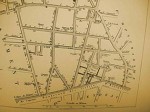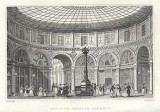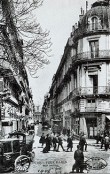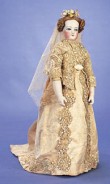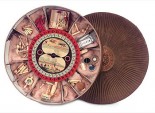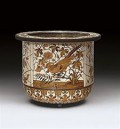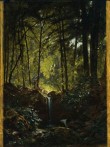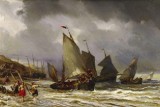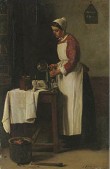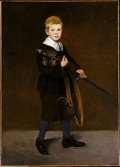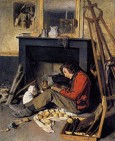The browser will either open the file, download it, or display a dialog.
Most nineteenth-century scholars agree that, by the end of the Second Empire, Paris had become a city of spectacles, a city in which the character of the flâneur defined a new way of relating to the urban environment via visual consumption.[1] The city’s transformation had started well before the Second Empire and many of the structures and institutions needed to indulge in the leisure of looking were already in place during the July Monarchy in 1830s and 1840s. The new residential quarters north-west of the old center of Paris, the streets around the Bourse, the numerous passages that allowed shoppers to stroll without the nuisance of the traffic, the asphalted streets with modern apartment blocks, and the banking sector of the Chaussée d’Antin and the rue Laffitte, all provided public places where one could engage in the visual consumption of all sort of goods (figs. 1, 2).
The modern art gallery was born alongside the new passages and department stores. Indeed, contemporary art played an essential role in the ever-changing visual display offered by the city. In 1858, the poet and art critic Théophile Gautier wrote in an article in L’Artiste:
The rue Laffitte is like a permanent Salon, an exhibition of paintings that lasts the whole year round. Five or six shops offer in their windows a constantly changing selection of paintings, which are illuminated by powerful reflectors.[2]
Gautier’s observation provides an interesting early insight into the topic of the commodification of art and the encroachment of the private dealers on the monopoly that the official Salon held over the visual consumption of contemporary painting during the July Monarchy and the Second Empire Paris. His article is part of a larger body of texts that, since the 1830s, recognized that contemporary art dealing existed outside the Salon. In these texts, writers were acutely aware of the transformation of art dealing practices. They seemed to accept them as yet another manifestation of Paris's coming of age as a modern capitalist urban center, as did this anonymous writer for L’Artiste in 1835: “In the end, the shop displays at Giroux, Suse and Durand-Ruel are exhibitions established in sole interest of the artists. . . . They would be wrong to resist the spirit of the time. Today everything is commerce. For artists, commerce replaces the patronages of the princes and the lords.”[3] In the new galleries to which the article in L’Artiste refers, art had become one kind of fashionable luxury item among others, created to please the passersby who were easily dazzled by the shimmering surfaces and the pleasing scenes depicted in the paintings in the shop windows.
Using Gautier’s comments as a starting point, this article proposes to investigate the essential role played by art dealers in the shaping of Parisian middle-class taste for contemporary painting. The middle class was far from being a unified group. During the nineteenth century, it was clearly understood that there was a huge range between the high bourgeois and the petty bourgeois, who lived on a fixed income. The segment of the middle-class that concerns us today is the middle segment: the professionals, the civil servants and the magistrates, the university professors, the army officers, and the small stockholders living on private means.[4] Alfred Sensier, a civil servant working at the Ministère de l’intérieur, republican, friend of Millet and Rousseau, and self-appointed promoter of the Barbizon school, represented the archetype of this new bourgeois collector. Unlike some of his middle-class counterparts who pursued a different type of collecting during this period [5] Sensier was not interested in emulating the aristocratic collecting practices of the Ancien Régime. Instead, Sensier was principally interested in contemporary painting.[6]
Collectors such as Sensier were the beneficiaries of the modernization of the French economic model. For them buying art was a way to participate fully in the development of a culture based on consumption.[7] The arrival on the Parisian art scene of this type of collector provided the art dealers with new business opportunities. And while there were more art consumers in Paris than before, the number of painters also had risen quite significantly, to about four thousands painters during the Second Empire. So art dealers were guaranteed to have at their disposal an endless supply of work to renew their inventory.[8] Painting was a luxury but plentiful item.
Using the rue Laffitte as a case-study, this article will chronicle how dealers starting in the 1840s catered to a clientele that might not have found what they liked on the Salon walls. To do so they created an effective alternative to the official exhibition and undermined its authority by providing potential art buyers with a different kind of aesthetic experience. By the end of the century, the art galleries had acquired a legitimacy that would consecrate the alliance between modern painting and the market. This alliance would allow financial success for the galleries and their owners as well as for modern artists and the avant-garde.[9]
We must first try to understand how the art market had developed during the July Monarchy.[10] In a seminal article, Nicholas Green has described the now familiar process of the transformation of the art supplies and luxury goods establishments into shops selling exclusively contemporary paintings.[11] In the 1830s, the new merchants selling contemporary paintings started leaving the neighborhoods of the Ecole des Beaux-Arts and the Académie de Saint-Luc on the left bank, to settle on the right bank in the streets around the Bourse—symbol of the new trust placed by France in a market economy. In that neighborhood, the rue Laffitte quickly became one of the foremost Parisian streets for art dealing.[12] Art galleries set up shop there from the mid-1840s onward, and by the end of the century there were at least twenty galleries.[13]
Rue Laffitte is 500 meters long (fig. 3) from the boulevard des Italiens, which opened into a world of cafés, restaurants and other entertainments establishments, to the rue de Châteaudun and the Church of Notre Dame de Lorette. It was the home to a microcosm of Parisian modern society, from the banker James de Rothschild and the composer Jacques Offenbach to the aventurière Lola Montès, the journalist Emile de Girardin, and the poet Marceline Desbordes-Valmore. Far from the aristocratic left bank, its inhabitants represented the new Paris, the one that would come to full power during the Second Empire. Long before La Revue blanche, which published its first issue in 1891, moved its headquarters to 1, rue Laffitte at the end of 1893, Etienne Carjat, the caricaturist and photographer (fig. 4), had chosen the rue Laffitte for the office of his journal Le Boulevard. This signaled that the power of the rue Laffitte may have derived from the marriage between modern capitalism, its entrepreneurial spirit, and new cultural institutions such as Carjat’s journal. But the rue Laffitte was also the street where women came to buy hats at Mme Guichard’s and had their dresses made by the famous fashion house Palmyre. And, when the rue Laffitte was still called rue Cerutti, Napoléon III was born there in 1808, in the Hôtel Bollioud de Saint Julien, where his mother, Queen Hortense held a very popular salon.[14]
In 1844, Louis Lurine edited a volume called Les Rues de Paris, for which Eugène Guinot wrote the section about the rue Laffitte. While Guinot did not mention art galleries, he described the rue Laffitte as "having renounced public affairs, to engage quietly with trade, arts, and pleasure.”[15] Ten year later, in 1854, when Frédéric Henriet published in L’Artiste an ambitious article about the state of art dealing in Paris, the rue Laffitte had become “the street of pictures,” “the valley of temptation,” “a street museum.”[16] Like Gautier, Henriet insisted on the idea of the stroll and of the thrill of discovery: “The rue Laffitte has become for the amateurs (collectors) a pretext for a stroll.”[17]
Before the 1830s, the middle-class collectors who preferred landscapes, genre scenes or still-lifes and who did not want to purchase paintings at the official Salon had two choices. One was to go to an artist’s supplies store; the second was to go to a luxury shop where one could buy anything from umbrellas, porcelain dolls, and stationery to leather goods, paperweights, and other knickknacks (figs. 5, 6, 7).[18] In these shops one could not only buy contemporary paintings, one could even rent them.[19] In 1827 Alphonse Giroux had founded with his wife and daughter a shop devoted to pictures, stationary and curios. In his 1833 catalogue, he advertised rental pictures for six francs a month, while drawings or prints could be rented for three francs a month.[20] While the custom of leasing paintings was apparently popular in the early half of the nineteenth century,[21] by the end of the century it had practically totally disappeared.[22] This supports the idea that as that as the middle class grew richer, owning paintings became a desirable marker of success. As art collecting was perceived as a respectable way to invest one’s money, contemporary painting became a precious commodity, making ownership an essential component of the visual consumption of the object.[23]
By the early 1850s, art dealers had found their legitimate place in the rue Laffitte, by then one of the busiest streets for pedestrian traffic. Gautier mentioned seven galleries in 1858. The oldest, richest, and most elegant was that of Adolphe Beugniet, located at 10 rue Laffitte. Opened in 1842, this gallery catered to an upscale clientele of amateurs. Beugniet dealt only in the works by artists who already had a reputation; he did not help young talent to develop. Among his roster of artists, many of whom were his friends, we find landscapists such as Constantin Troyon, Camille Corot, Narcisse Diaz de la Peña, Théodore Rousseau, François-Louis Français (fig. 8), Charles-François Daubigny, Camille Roqueplan, and Antoine Chintreuil, in addition to orientalists like Eugène Fromentin; marine painters like Eugène Isabey (fig. 9); and artists like Félix Ziem (fig. 10) and Théodore Frère who produced paintings in many genres.[24] But Beugniet also bought Degas’s fans, and Delacroix regularly sold small paintings to him in the 1850s.[25]
Beugniet was one of the most successful dealers of the street. Others ran more modest establishments. Cornu, who carried stationary and paper products as well paintings, catered to a second tier of the new middle-class clientele. Génin specialized in drawing. The former actor Cachardy specialized in the naturalist works of Bonvin (fig. 11) and Tassaert. La Belle Jeanne, a former artists’ model, supported the students of the artists for whom she had modeled.[26] Some galleries, like the print shop of dealer-printer Louis Dumont at 23 rue Laffitte represented only one genre of painting, in this case the painters of the Forest of Fontainebleau.[27] Finally, dealers like Alexis Fèbvre expanded their practices and took full advantage of the growth of auction sales. In the 1850s, Fèbvre made his reputation as a valuing expert at Drouot, and, while he sold paintings by old masters such as Jean-Baptiste Oudry, he was also one of the first to buy a Manet (fig. 12).[28] By the 1860s, galleries such as Paul Détrimont’s, at 27 rue Laffitte, functioned as an alternative to the Salon. In 1860, he exhibited Satan auprès d’Eve a painting by Belgian artist Fréderique Miethe O’Connell, which had been rejected by the Salon jury. Like many dealers in the rue Laffitte, Détrimont made extensive use of his store windows and exhibited with great success one of Amand Gautier’s numerous paintings of the Sisters of Charity (fig. 13).[29] The success of the galleries in the rue Laffitte confirms, as Patricia Mainardi has convincingly argued, that by the end of the Second Empire, the Salon could no longer pretend to dominate the French art scene.[30] The viewing experience had become so inadequate that despite the Salon’s stern self-proclaimed anti-commercial stand, critics did not hesitate to call it a “fair” or a “bazaar,” and proposed that, instead of the Salon, art lovers visit art galleries as the only civilized alternative.[31] Zacharie Astruc, writing after his visit to the Salon in 1860, encouraged his readers to go to the boulevard des Italiens, to see “the new exhibition of modern painting,” which he described as an “intimate salon,” in contrast to the Salon which he found to be a “Capernaum,” and a “frames fair.” He commented about the quiet atmosphere and the excellent viewing conditions, describing the new kind of lampshades, which illuminated the painting without creating any glare for the viewer.[32]
The exhibition to which Astruc referred was held at the gallery of Louis Martinet, a former student of Antoine Gros, who was strongly influenced by the philosophy of the Count of Saint-Simon. Martinet had built a gallery in 1859 in the gardens of the Marquis of Herford, which were accessible from both 26 Boulevard des Italiens, and the rue Laffitte.[33] Shunning the commercial model, Martinet wanted to support artists by organizing a kind of cooperative. He envisioned a kind of hybrid institution—part art gallery and part exhibition hall. While art galleries at the time did not charge an entrance fee, he did. Artists paid a membership fee so they could exhibit in Martinet’s gallery, and they would then be entitled to receive a percentage of the entrance fees.[34] With this unique model, Martinet and the artists could derive income from two sources; from the entrance fees and from sales. Ultimately, Martinet wanted the artists to learn to become businessmen so they could manage their own affairs. He transformed the gallery into a meeting place, with smoking room and boudoirs, that also hosted concerts and exhibitions of old masters. Martinet was especially interested, as were many in those days, in the correspondence between painting and music. His audience could listen to Mendelssohn while attending a Corot exhibition, and he similarly paired Delacroix with Berlioz, and Raphael with Mozart.[35]
Against the Salon, the galleries of the rue Laffitte reversed the commercial/anti-commerce equation in their favor. They positioned themselves as paradigms of taste and elegance, promoting the quality and exclusive nature of the public viewing experience, an experience that started outside, on the sidewalk, with the shop window.[36] Galleries continued to play up the difference throughout the century.[37] They adopted different hanging practices, limiting the number of works displayed on each wall to make accessing the works easy, especially for Americans, who had become, by the mid-1880s, major buyers of both academic and avant-garde French Art. It was a hanging practice that American collectors were used to as the New York art galleries were the first to experiment with isolating one painting per wall panel in order to make it look more precious.[38]
Much of the success of the new galleries was due to the fact that, around the 1850s a new breed of neophyte collectors had entered the market. Too timid to buy directly from the artists at the Salon, they also lacked the confidence to buy at auction. The art dealer became a reassuring middleman to a clientele that was much more familiar with the codes of commerce than with the codes of the artist’s studio.[39] Art dealers created a complex system to support the uneducated new customers. With the help of art critics and the developing art press, they acted as taste makers, guiding the purchases of the new collectors.[40] The rue Laffitte provided the training ground for the new collectors, offering a familiar environment in which they could learn how to look at contemporary art and develop their connoisseurship skills in a context different from the Salon and less risky than the auction house.
Though this new class of collectors allowed for an increasing number of painters in Paris to survive, criticizing their taste became a major activity of critics and caricaturists in the middle of the nineteenth century. The belief that, under pressure of the necessities of the new art market, art would degenerate into domestic decoration became a major public concern.[41] As early as 1836 Alexandre Barbier had told artists to adapt to the taste of what he called “the new masters."[42] Later on Gautier, always ambivalent about his audience, mentioned that the size of paintings displayed in the “musée de la rue Laffitte” was now dictated by the size of the modern bourgeois apartment.[43] Artists also took notice of these changes, and by the late 1860s, most, like Jules Breton, were resigned to the fact that, if artists wanted to survive in a free market, they had to adapt.[44]
In mid-century Paris, what kind of art was sold in art galleries? Was there a style, a genre that one could identify as thriving on the rue Laffitte? As Théophile Gautier strolled down the street and looked through the shop windows, he identified what he called “the Rue Laffitte School,” which he defined as an art whose main purpose was to be saleable; that is, fashionable and eye-pleasing paintings, aimed to charm.[45] More importantly, Gautier recognized that what dictated the content and the style of the artist’s work is the fashion of the season, what style was in vogue at the moment. In one season, it could be thickly and broadly applied paint, in the next a taste for delicate and detailed brushwork or a monochrome palette with thinly applied paint. For Gautier the negative effect of this constantly changing display of pictures was that it forced artists to adapt to what was popular. He realized that in the art trade, as in other retail businesses, the clients’ taste ruled and artists needed to produce formulaic painting, rather than challenge themselves.[46]
What Gautier called “the Rue Laffitte School,” Champfleury called “the Deforge School,” referring to one of the art dealers of rue Laffitte, and Baudelaire, in his review of the 1846 Salon, called “the Couture School.”[47] In this category, Baudelaire grouped together artists like Henri Baron, Faustin Besson (fig. 14), and Célestin Nanteuil, who were producing small cabinet paintings with thick, colored impasto, reminiscent of Watteau and Chardin.[48] For Baudelaire, the work of Besson looked weaker on the Salon wall than in the galleries of the rue Laffitte, as it was lacking the protective barrier of the shop window whose reflective surface added to the shimmering of the painting surface.[49] The shop window hid the imperfections of these paintings, made with ease and a certain bravura, typical of Couture’s working method, but in a hurry to satisfy the fashion of the season.[50]
Attracted by minor genres, as well as by 'minor’ media such as sketches, drawings, and watercolors, a new breed of collectors entered the market seduced by the modest prices asked by the dealers of the rue Laffitte. The collection of the opera singer Paul-Bernard Barroilhet (1810–71), which was sold at auction in 1855, reflects the taste of the collectors who bought works on the rue Laffitte.[51] He owned six Coutures, eleven paintings by Diaz, some Roqueplans and a few Tassaerts (fig. 15), along with paintings by Chardin, Boucher and Watteau.[52]
Through the accounts of Gautier and others, we have witnessed the creation of the contemporary art gallery, a new commercial establishment aimed at serving a patron base of newly prosperous “middle bourgeois.” The emergence of this new clientele led to the development of what I propose to call a peinture bourgeoise (middle-class painting), largely composed of still-life, animal painting, landscape, and orientalist scenes. Painted in a juste-milieu style that privileged texture and color over drawing, the works created for this clientele were often modest in size and in medium (watercolor, drawing, and sketch).[53] Despite his reservations, Gautier recognized that these new shops with their ever-changing display promoted collecting.
The galleries in the rue Laffitte exemplified the contemporary art gallery of the Second Empire. When it came to visual consumption, the rue Laffitte offered a strange mix between the public and the private, the commercial and the anti-commercial. It proposed a new way to relate to contemporary art, which borrowed quite a lot of its codes from the world of material consumption. The merging of business and contemporary art became the staple of this new way to relate to artistic production. If department stores regularly organized painting exhibitions, it was no problem for exclusive galleries to attract their clientele with department store-like window display.[54] The shop windows were their public side, the side which connected more blatantly with the world of commerce, while the inside of the gallery brought vision of a refined private space, where commercial connotation all but disappeared emulating one’s private home. For the collectors, commercial galleries' spaces— providing an alternative to the Salon—were public spaces imbued with private qualities, quiet, elegant, with an exclusive and homogenous clientele, far from the busy spectacle of the street which had originally brought them in.
All Translations, unless otherwise noted, are the author’s.
I would like to thank Karen Maguire, Librarian at Christie’s Education New York, for the valuable support she gave me while I was researching this article. Grateful thanks also go to Christie’s Education Graduate Assistants Kirsten Nicholas and Allison Galgiani for their help during the final stage of the project.
[1] Anonyme, Le Flâneur au Salon vu par M. Bonhomme: Examen joyeux des tableaux, mêlé de vaudevilles (Paris: M. Aubry, 1806), n.p. For a more in-depth discussion of the topic see Christel Hollevoet-Force, "Le Flâneur: A Genealogy of a Modern Icon" (PhD diss., The Graduate Center of the City University of New York, 2011).
[2] " La rue Laffitte est une sorte de Salon permanent, une exhibition de peinture qui dure toute l’année. Cinq ou six boutiques offrent derrières leurs vitrines des tableaux sans cesse renouvelés sur lesquels de puissants réflecteurs concentrent la lumière. " Théophile Gautier, “La Rue Laffitte,” L’Artiste, 7th ser., 13, no. 1 (January 3, 1858): 10–13.
[3]“Ainsi les étalages de Giroux, de Suse et de Durand-Ruel ne sont, à bien dire que des expositions établis dans l’intérêt des artistes. . . . Il y aurait mauvaise grâce à résister à l’esprit de son temps. Tout est aujourd’hui commerce. Le commerce remplace pour les artistes le patronage des princes et des grands seigneurs.” “Du Commerce d’objets d’art,” L’Artiste, 1st ser., 10, no. 21 (October 15,1835): 237, http://gallica.bnf.fr/ark:/12148/bpt6k199642/f312. While it seems incongruous for us today to associate Durand-Ruel, the epitome of the visionary dealer, with merchants of luxury goods such as Suse and Giroux, it clearly demonstrates that in the 1830s dealing in contemporary painting was only one aspect of the luxury trade.
[4] For more information see Hugh Collingham, The July Monarchy: A Political History of France, 1830–1848 (London: Longman, 19880; Adeline Daumard, La Bourgeoisie parisienne de 1815 à 1848 (Paris: Ecole Pratique des Hautes Etudes, 1863); André Jardin and André-Jean Tudesq, La France des notable, l’évolution générale 1815–1848 (Paris: Le Seuil, 1973).
[5] One such example is Louis La Caze, a French physician who donated his collection to the Louvre at his death in 1869. Unlike his aristocratic rival Lord Hertford, who was one of the most distinguished residents of the rue Laffitte and whose collection now forms the Wallace Collection, La Case was on a limited income. He focused on works that were undervalued at the time, such as rococo and Spanish seventeenth-century paintings. For more information about La Caze see Guillaume Faroult and others, La Collection La Caze: Chefs d'œuvre des peintures des XVIIe et XVIIIe siècles (Paris: Hazan, 2007).
[6] It is beyond the scope of this article to discuss Sensier’s career in more detail, but it is informative to know that he built his collection between 1839 and 1863, making a sizable profit when in 1873 he sold part of it to Durand-Ruel for 260,000 francs. For more information about Alfred Sensier see Christopher Parson and Neil McWilliam, “Le Paysan de Paris: Alfred Sensier and the Myth of Rural France,” Oxford Art Journal 6, no. 2 (1983): 38–58.
[7] The issues surrounding these middle-class collectors are complex, and demand further studies. While monographic studies on specific collectors are useful, they are too often hagiographic in nature. They lack the critical distance to allow us to understand collecting as a defining component of the crystallization of bourgeois identity in mid-nineteenth-century France. The following essays provide me with useful ways to think beyond the individual: Albert Boime, “Les hommes d’affaires et les arts en France au 19e siècle,” Actes de la recherche en sciences sociales 28 (June 1979): 57–75; Richard Wrigley, “The Class of 89?: Cultural Aspects of Bourgeois Identity in France in the Aftermath of the French Revolution,” in Art in Bourgeois Society, 1790–1850, ed. Andrew Hemingway and William Vaughan (Cambridge: Cambridge University Press, 1998; and Bernard Vouilloux, “Le discours sur la collection,” Romantisme 31, no. 112 (2001): 95–108.
[8] In the 1860s,the average price for a landscape painting by a French living artist was 1,443 francs, against 2,861 francs for a genre painting and 6,637 for a history painting. Harrison C. White and Cynthia A. White, Canvas and Careers: Institutional Change in the French Painting World (Chicago: University of Chicago Press, 1992), 38.
[9] Picasso writing to Paul Rosenberg saying “together we will be invincible,” is probably one of the best known instances of an avant-garde artist recognizing that success can only come with the support of an art dealer. See Michael Fitzgerald, Making Modernism: Picasso and the Creation of the Market for Twentieth-Century Art (Berkeley: University of California Press, 1998), 66.
[10] A complete panorama of the art market in Paris should of course include a mention of the auction house, especially after the opening of the new Hôtel Drouot in 1852, in the same neighborhood as the rue Laffitte. The auction house was at the center of the Parisian art market. The numerous estate sales and the sales organized by the Barbizon artists since the 1850s catered to the same collectors that came to rue Laffitte to buy landscape and genre paintings. For more information on the role of the auction house see Simon Kelly, “’This Dangerous Game’: Rousseau, Diaz and the Uses of the Auction in the Marketing of Landscapes,” in Soil and Stone: Impressionism, Urbanism, and Environment, ed. Frances Fowle and Richard Thompson (Aldershot: Ashgate Publishing, 2003), 33–48.
[11] Nicholas Green, “Circuits of Production, Circuits of Consumption: The Case of Mid-Nineteenth-Century Art Dealing,” Art Journal 48, no. 1 (Spring 1989): 29–34.
[12] In 1867 Durand-Ruel, who was not yet the dealer of the Impressionists, had left the rue de la Paix to open his gallery on the rue Laffitte, to be followed later in the 1890s by more visionary entrepreneurs fully committed to modern art, such as the Natanson Bothers who opened the Revue blanche at number 1 in 1894, and Ambroise Vollard who, after a couple a of stops along the street, ended up at number 6. Galerie Bernheim Jeune would be the first to leave in 1900, signaling the continuous migration of the art market, this time toward the 8th arrondissement near the lower portion of the Champs Elysées.
[13] For an enlightening analysis of the relationship between avant-garde culture and commerce, see Janis Bergman-Carton, “La Revue Blanche: Art, Commerce, and Culture in the French Fin-de-Siècle,” Nineteenth-Century Contexts 30, no. 2 (June 2008): 167–89. Bergman-Carton draws some interesting parallels between the Revue Blanche move to rue Laffitte and its increased coverage of the arts either through articles or in the form of advertisements for the dealers on the rue Laffitte (at page 184).
[14] Eugène Guinot, "Rue Laffitte," in Les Rues de Paris, ed. Louis Lurine (Paris: Kugelmann éditeur, 1844), 112.
[15] "renoncée aux affaires publiques, pour se livrer sans troubles au commerce, aux arts, aux plaisirs.” Ibid., 113.
[16] “rue des tableaux,” the “vallée des tentations,” and the “musée de rue.” Fréderic Henriet, “Le Musée des rues: Le Marchand de tableaux " L’Artiste, 5th ser., 13, no. 8 (November 15, 1854): 113–14.
[17] “La rue Laffitte est devenue pour les amateurs [collectionneurs] un prétexte et un but de promenade." Ibid., 114.
[18] For more information about the Maison Giroux see Danielle Kisluk-Grosheide, “Maison Giroux and its Oriental Marquetry Technique,” Journal of the Furniture History Society 34 (1998): 146–72.
[19] Tabarant was very critical of this practice: “Tableaux à vendre? Non, tableaux à louer. Car là est l’aberration du négoce artistique. Le pair de France, le notaire, le procureur, le rentier cossu, l’homme de finance, louent des tableaux comme ils louent des lustres.” Indeed, paintings were not the only things you could rent in the 19th century; you could rent most anything, from servants in uniform, table linen, and china to candelabra and chandeliers. See A. Tabarant, La Vie artistique au temps de Baudelaire (Paris: Mercure de France, 1942), 13.
[20] See Catalogue des tableaux du cabinet de MM. Alph. Giroux, Vente 16 décembre 1833 (Paris: Henry, 1833).
20 Nicholas Green documented the fact that art suppliers often advertised together pictures for rent and prepared canvases. See The Spectacle of Nature. Landscape and Bourgeois Culture in Nineteenth-Century France (Manchester, UK: University of Manchester Press, 1990), 26.
[22] People rented paintings for two main reasons: to decorate their home and impress visitors during parties or, if one were either an art student or an amateur artist, to copy them. While the practice was no longer advertised after the 1850s, as late as the 1880s Durand-Ruel was "hiring out" paintings by living artists such as Bouguereau to art students, especially to female artists who could then paint in the privacy of their home. It is interesting to note that Durand-Ruel was sending prepared canvases along with the paintings. See Louise d’Argencourt, “Bouguereau et la marché de l’art en France,” in Bouguereau 1825–1905, ed. Alexandre Gaudieri, exh. cat. (Paris: Galeries du Petit Palais, 1984), 95–103.
[23] Pierre-Marc de Biasi explains how the July Monarchy constitutes the period when the urban middle-class grows into its own as collectors. He convincingly connects the rise of this new type of buyer and the introduction of the word “collectionneur.” See Pierre-Marc de Biasi, “Système et déviances de la collection à l’époque romantique (Le Cousin Pons),” Romantisme, no. 27 (1980): 81.
[24] On Beugniet, see Pierre Miquel, Art et argent 1800–1900: L’école de la nature (Maurs-la-Jolie: Edition de la Martinelle, 1987), 6:403.
[25] About Delacroix’s dealings with private collectors and with Beugniet, as well as the Comte de Forbin’s awareness of the challenges that this growing private dealing could have on French art, see Elisabeth A. Fraser, “Uncivil Alliances: Delacroix, the Private Collector and the Public,” Oxford Art Journal 21, no. 1 (1998): 87–103; and about Degas’s fan, see Marc Gerstein, “Degas’s Fans,” Art Bulletin 64, no. 1 (March 1982): 105–18.
[26] Much more research needs to be done before we can re-construct in a more complete way the career of these dealers. At the moment, what is accessible is spotty at best. Pierre Miguel’s book has some basic information about these dealers. See Miquel, Art et argent,6:399–409.
[27] We know that Dumont bought paintings by Millet at the Charles Tillot sale in 1887. See Alexandra Murphy and others, Drawn into the Light: Jean-François Millet, exh. cat. Pittsburg: The Frick Art Museum (New Haven: Yale University Press, 1999), 45.
[28] Like Francis Petit, Fèbvre would also organize auctions of his own inventory under the guise of anonymous collectors. About Fèvbre see Paul Eudel, L’Hôtel Drouot et la curiosité (Paris: Georges Charpentier,1883), 2:238–342.
[29] Détrimont, like many of his colleagues of the rue Laffitte, worked as an expert during auctions sales. He also collaborated with Francis Petit (Georges Petit’s father) on organizing exhibitions at the Cercle de l’Union Artistique, rue de Choiseul. He supported artists such as Corot, Jongking, and Cals. Courbet seemed to have had a good relationship with him during the 1860s; Courbet mentioned that Détrimont wanted to exhibit his Stonebreakers in his shop window, and in April 1861, he told Francis Wey that Détrimont was his dealer, but by 1863 their relationship seems to have gone sour and Courbet mentioned that he wanted to bring action against Détrimont as he owed him five hundred francs. See Petra ten-Doesschate Chu, ed., The Letters of Gustave Courbet (Chicago: The University of Chicago Press, 1992), 180, 192, 217. For information about Fréderique Miethe O’Connell see Eliane Gubin, Dictionnaire des femmes belges, XIXème and XXème siècle (Brussels: Editions Racine, 2006), 402.
[30] Patricia Mainardi, The End of the Salon: Art and the State in the Early Third Republic (Cambridge: Cambridge University Press, 1993).
[31] For more in-depth discussions of the issue see Nicos Hadjinicolaou, “The Debate at the Salon of 1831,” Block, no. 9 (1983): 62–67; Patricia Mainardi, “The Eviction of the Salon from the Louvre,” Gazette des beaux-arts 6th ser., 112 (July-August 1988): 30–40; Mainardi, End of the Salon; and Maria Ivens, Le Peuple-artiste, cet être monstrueux, la communauté des pairs face à la communauté des génies (Paris: L’Harmattan, 2007).
[32] "Capharnaum," "Foire aux cadres," Zacharie Astruc, Le Salon intime, exposition au boulevard des Italiens (Paris: Poulet-Malassis et de Boisse, 1860), 17, 24.
[33] Martinet was the first one to give Manet regular exhibitions, starting in 1863. See Jérôme Poggi, "Les Galeries du boulevard des Italiens, antichambre de la modernité," 48/14 La Revue du musée d’Orsay, no. 27 (Fall 2008): 22–33.
[34] The idea of making the public pay to see works of art was not new in the 1860s, and there had been many precedents, from Jacques Louis David’s exhibition of his Sabine Women in a room at the Louvre, to the 1846 Exposition du Bazar Bonne-Nouvelle. For more information about “pay to see” exhibitions, see Jérôme Poggi, “Painting to Be Seen versus Painting to Be Sold: The Paying Exhibition as an Alternative to the Commercialization of the Work of Art under the Second Empire,” accessed July 16, 2011, http://artsetsocietes.org/a/a-poggi.html and Fondation Taylor, Le Baron Taylor, l’Association des artistes et l’exposition de Bazar Bonne-Nouvelle en 1846 (Paris: Fondation Taylor, 1995).
[35]Le Courrier artistique (April 15 1863): 4.
[36] Vollard was the only exception to the rule; his gallery continued the tradition of the bric-à-brac shop: paintings were piled on the floor and stacked against each other.
[37] By 1882, an announcement in La Vie parisienne of Georges Petit’s new gallery space said: “The era of the central market for painting has passed. There is nothing more out of fashion, more vulgar, and smellier than this huge bazaar of the Champs-Elysées, where cars, cheese and picture follow each other.” This reference to vulgarity and smell was an allusion to the fact that the Salon was no longer held at the Louvre but at the the Palace of Industry. Petit’s new space was described as a: “meditative temple”; a luxurious gallery, with thick and soft carpets, rare flowers, a large staircase and high halls, antique busts, all this accompanied by the buzzing of Parisian fashion.” La Nouvelle Salle d’exposition de la rue de Sèze, " La Vie parisienne, February 25, 1882, 119.
[38] See Lois Marie Fink, “French Art in the United States, 1850–1870: Three Dealers and Collectors,” Gazette des beaux-arts 6th ser., 92 (Spring 1978): 94; Madeleine Fiddell-Beaufort and Jeanne K. Welcher, “Some Views of Art Buying in New York in the 1870s and 1880s,” Oxford Art Journal 5, no. 1 (1982): 48–55; and Leanne Zalewski, “Alexandre Cabanel’s Portraits of the American 'Aristocracy’ of the Early Gilded Age,” 19th Century Art Worldwide 4, no. 1 (Spring 2005), accessed September 8, 2011, http://www.19thc-artworldwide.org/spring05/alexandre-cabanels-portraits-of-the-american-aristocracy-of-the-early-gilded-age.
[39] When painter Antoine Guillemet compiled documentation to help Emile Zola with the writing of L’Oeuvre (1886), he commented on the fact that amateurs preferred dealing with art dealers, as they do not dare to barter with artists and are always worried that the artists will take advantage of them. Émile Zola, Carnet d’enquête: Une ethnographie inédite de la France (Paris: Poche, 1991), 358.
[40] Dealing in depth with that issue is beyond the scope of this article. But we should mention that between 1861 and 1865 Louis Martinet published Le Courrier artistique and that in 1869 Durand-Ruel founded his own art magazine called La Revue internationale de l’art et de la curiosité. Specialized guides such as François-Xavier Burtin’s Traité de connaissances nécessaires aux amateurs de tableaux (Paris: Renouard Librairie, 1808) were published throughout the period.
[41] See Wrigley, “Class of 89?," 131.
[42] "Dans nos démocraties modernes, où les richesses sont éparpillées, où la toute puissance réside de fait dans les classes moyennes il faut bon gré mal gré que l’art s’accommode au goût des maîtres, qu’il rapetisse au niveau de leur fortune, qu’il se proportionne à l’exiguïté de leur demande sous peine de mourir à l’hôpital." Alexandre Barbier, Salon de 1836 (Paris: Joubert Libraire Editeur, 1936), 38.
[43] "au musée de la rue Laffitte, là où l’art se fait petit pour entrer dans les étroites alvéoles que l’architecture moderne nomme de nom fastueux d’appartement, dont pourrait tapisser toutes les pièces avec un tableau d’histoire coupé en morceaux." Gautier, "Rue Laffitte," 11.
[44] "On ne se figure pas jusqu’où allait l’ignorance. . . . Je me souviens, au temps de ma jeunesse, que les bourgeois en était encore à cette affirmation qu’ils croyaient flatteuse, lorsque l’on leur montrait un tableau: Que de coups de pinceaux ! Ou à cette question: ce qu’il y a de plus difficile, n’est ce pas le mélange des couleurs? Non, répondait un connaisseur, c’est l’écaille du poisson. Telle était l’idée que se faisaient de l’esthétique des professeurs, des avocats, des médecins." Jules Breton, Nos peintres du siècle (Paris: Société d’Édition Artistique, 1899), 41.
[45] “une espèce de peinture tout en vue de la vente; "couleurs claires, habileté à reproduire la réalité"; “un peu routinier, le public demande à chaque artiste presque toujours la même chose.” Gautier, "La Rue Laffitte," 12.
[46] “Les artistes trouvent là les même ressources que les poètes dans le feuilleton du petit journal, le louis quotidien.” Ibid., 12–13.
[47] Henriet, "Le Musée des rues," 115.
[48] See Charles Baudelaire, “Le Salon de 1846,” in Ecrits sur l’art (Paris: Gallimard, Livre de Poche, 1971), 1:194–96.
[49] Ibid., 194.
[50] “La couleur de M. Faustin Besson pert beaucoup à n’être plus troublée et miroitée par les vitres de M. Deforge.” Ibid., 195.
[51] While these collectors were not daring enough to buy the work of Manet and, later, of the Impressionists, they a set precedent in the kind of contemporary art they bought, rejecting the official dictate of the Academy and what they saw at the Salon. They established a role model for the early collectors of Impressionism such as Jean-Baptiste Faure, an operatic baritone; or Victor Chocquet, a French civil servant. See Anne Distel, Impressionism: The First Collectors (New York: Harry N. Abrams, 1998).
[52] Vouilloux, "Le discours sur la collection," 96.
[53] In 1851, Clément de Ris writing for L’Artiste talked about trade pictures or “tableaux de commerce,” referring to genre and landscape painting. He made the pertinent connection between the state of the art market in 17th-century Holland, the Dutch middle-class taste for genre painting and what he was seeing happening in Paris: “Cette faveur marquée pour ce que l’on appelle plus particulièrement le genre, a développé chez les artistes qui s’y consacrent une masse de talents dont l’équivalent ne se retrouve que chez les Hollandais du beau temps dix-septième siècle.” Clément de Ris, “Le Salon de 1851, III,”L’Artiste 5th ser., 5, no. 6 (February, 1, 1851): 3.
[54] In March 1846, The Bazar Bonne-Nouvelle hosted the first exhibition of the Association des Artistes Peintres, Sculpteurs, Architectes et Graveurs. It was organized by Albert de La Fizelère and Léon Techener, and reviewed by Baudelaire in Le Corsair-Satan as “Le Musée classique du Bazar Bonne-Nouvelle.” Later in the century other departments stores such as Le Bon Marché organized regular art exhibitions. See James Kearns “’Niera-t-on le pouvoir des arts?’ Revisiting Jacques-Louis David at the 1846 Exhibition in the Bazar Bonne-Nouvelle,” Modern Language Review 102, no. 3 (2006-7): 672–86.


